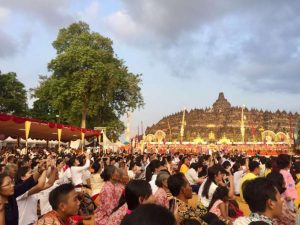
As a young girl, I spent many dark nights reading The Juniper Tree and Other Tales from Grimm (Farrar, Straus & Giroux 1974), a double set of Grimm’s fairy tales illustrated by Maurice Sendak. I don’t believe my father read them before he gave them to me. If he had, he might have thought twice before setting me free into those violent stories of kidnapping, neglect, cannibalism, and other darknesses that had never before occurred to me. Perhaps that’s why, decades later, when I was searching for books to stock the library of the Buddhist elementary school I was starting, I instinctively rejected the most obvious choice—in a sense the only choice—the stories everyone assumed I would use . . . the famous Jataka Tales.
After paging through several editions, I made my decision: no Jataka, no way.
The Jataka Tales are an ancient collection of stories originating from the Indian subcontinent that were passed down through the ages, first as an oral tradition and later transcribed and translated into many languages. They are essentially the past life stories of the Buddha: stories of when he was a tiger or a beggar, an elephant or a king, but always a bodhisattva. There are about 550 of them, although some of those 550 only have titles and some have no titles.
Why no way? Most published versions are full of violence, aggression, misogynistic stereotypes, and other tropes that I felt were not relevant to today’s learners. For example, there are stories about owls who eat crows’ heads, greedy mothers, a son cleaving his father’s head open with an axe in order to kill a mosquito, spirits devouring men and scattering the bones, people so angry their hearts explode out of their mouths, vain women being reborn as dung worms, and so on. Dzongsar Khyentse Rinpoche once told me that we should be cautious about the media we consume, watching violence, gore, and bad behavior can create a karmic imprint. We might become accustomed to these images and recreate them in our next lives. At the very least they might penetrate a child’s dreams and give all involved a bad night’s sleep.

Nevertheless, when I told people that I was not planning to read these bloody tales to the five- and six-year-olds at the school, people were surprised. What would I use? It’s true that there is very little literature for Buddhist children, aside from these tales, so with reservations we did end up putting a few editions on our library shelves.
It soon became apparent that these books in our library needed a warning label. One of the non-Buddhist parents took one home and came back in shock. She had learned her lesson about previewing whatever you plan to read to your children. “I was like, oh my god! What are these stories?” she recalled. “I didn’t want my kids to have nightmares. Luckily, they couldn’t read yet so I just made up my own stories to go with the pictures, minus the misogyny and murder.”
Recently, my views on Jataka Tales have changed thanks to two wise women. And this parent’s on-the-spot rewrite is exactly what both of the wise women told me to do.
“Part of the problem with the Jataka Tales is that people think they have to adhere to the original, that the stories are carved in stone,” said wise woman No. 1, author, educator, and Zen teacher Ryuko Laura Burges. Laura’s book Buddhist Stories for Kids (Bala Kids 2022) is a wonderful reworking of 10 Jataka Tales.
Laura said she “couldn’t agree more” about the problems with the Jataka Tales, but because they are in the public domain, she felt free to reimagine them. “I wanted to have a wholesome, accessible message for children,” she said. Having worked with children for most of her life—she taught third grade for 35 years—she was able to make changes to the stories that retained the essence but aligned with growing minds. The result is wonderful.
“I wanted to turn that idea [of adhering to the ancient] on its head. We are Buddhist practitioners in this century, and we can take the kernel of truth in these stories and bring language, description, dialogue, and humor to make them available to children in a way that interests them. . . . That was my mission in writing this book.”
Laura went through hundreds of stories in a volume edited and translated by Edward Byles Cowell in the 1800s, which are kept in a special room at the San Francisco Library; “We had to wear gloves to touch the text.” She rejected many because the messaging was “beyond redemption.” For example, “If you do something wrong, you’re going to get trampled to death by an elephant, and later, that elephant is going to be born as the Buddha. What kind of message is that?”
But she found 10 tales that she wanted to work with, and set about turning men into women, adults into children, women into animals, a story of a Dharma teacher and his all-male students turns into a mother monkey teaching her mixed-gender chimps. She didn’t change all the male characters to female characters. “I just wanted it to be more balanced.” She also created happy endings with meaning. “I wanted there to be some illustration of deeper learning on the part of the characters and not just end it where the tables were turned. I’m trying to bring a softness and more compassion to the stories. So far nobody has criticized me or called me a heretic for playing with these stories in this way.”
Aside from the harshness, misogyny, and murder, I flinched from the heavy moralistic tone of the stories. This brings me to the second wise woman I spoke with: Kristin Lhatso, founder of the Snow Lion School, a Buddhist-inspired pre-K school in Boulder, Colorado, and organizer of Dzigar Kongtrul Rinpoche’s children’s program. I like to think of Kristin as a child-whisperer—akin to a horse whisperer. I’ve learned so much from just watching her interact with children.
Kristin loves the Jataka Tales (“LOVE!”) and has used them for decades in her children’s programs, especially with children aged 10 and younger. She sees their pitfalls but her biggest warning is against “amping up” the moral aspect.
“Sometimes grownups are the worst,” Kristin says. “They take a good story and stick a moral on it and ruin it. Children don’t like morals.” She suggests leaving the moral off at the end and letting children arrive at their own meaning. Otherwise, they are like, “Oh my god you’re just trying to make me be good.” It feels manipulative. It keeps the children from having their own agency.
For this reason, Kristin also leaves in a bit more of the dark side of the stories, such as the trope of the greedy mother, as a way to evoke the children’s internal sense of principles. “The kids instantly know it’s so wrong, they can feel it. It comes right up against their buddha-nature. What happens is that they can form their own picture, they are forming their own opinions. And their opinions are always good. Because it’s so obvious and it taps into their humanity. Like the stepmother in Hansel and Gretel. If you say it was wrong, it ruins it. If they say it, it allows them to hone their own moral code.”
Laura does include a one line moral at the end of each of her stories, which she describes as more of a talking point for the adults. But the goal of the writing is to evoke the children’s own inner compassion that they can put into words. This allows children to relate to the stories in different ways as they mature.
Kristin also highly recommends oral storytelling, rather than reading from scripture or translations. This is really the true lineage of the stories. “Telling stories orally is more powerful, it’s totally magic somehow.”
Like Laura, Kristin adapts the stories as she tells them. “They can also be hideously graphic and horrible, although they are not about what they seem to be about. When it comes to misogyny, I change the genders. I’ll even put in some nonbinary characters. I don’t think there is a problem with that. Of course, the Buddha wasn’t always a male.”
Kristin recommends the Noor Inayat Khan translation—the translator herself is quite a character worth reading up on. “They are the most well-written stories and my favorite by far. I have about 10 other versions, including a series published by Tarthang Tulku’s sangha with illustrations. Those are good to have as well.”
I’m grateful to these two wise ladies. They helped me understand that it’s possible to take these stories—the heart of so many traditionally Buddhist societies—out of their own socio-historical context and make them not just engaging but also relevant for children today.
It’s been a timely inquiry for me. Just before submitting this article, I received news from two colleagues, Pema Abrahams and Kuhn Sucharitakul, who are opening a Buddhist international school in Thailand. They informed me that they had finally chosen the name for the school: The Jataka School.
Pema explained that while there may be more than 500 Jataka Tales in the canon, in Thailand, Jataka refers primarily to the culminating 10 stories, which center beautifully on the 10 paramitas. There is much to say about this exciting new project. More to come!
See more
THE JUNIPER TREE and Other Tales from Grimm (2 volumes in a slip case) (A Cappella Books)
About The Jataka Tales (Middle Way Education)
Books – Jatakas (Dharma Publishing)
Related features from BDG
Buddhistdoor View: Celebrating the Many Lifetimes of the Bodhisattva in the Jatakas
The Blooming of Virtue and Morality: Storytelling in Mogao Cave 275
What is Violence? Self-immolation in Japanese Buddhism
Jataka Stories in Theravada Buddhism and The Ten Great Birth Stories of the Buddha – Book Review
Related news reports from BDG
Dalai Lama Gives First In-Person Public Audience in Two Years with Teaching from the Jatakas
Less Meat More Love! Khyentse Foundation Announces New Book for Children













